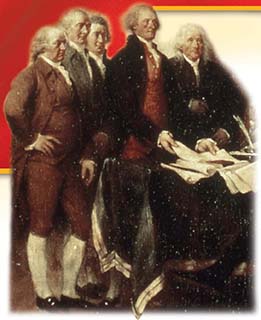SECTION 2: Declaring Independence

◄ Signing the Declaration of Independence
WITNESS HISTORY  AUDIO
AUDIO
The Spirit of Independence
In 1776, the Continental Congress decided to declare independence. But some colonists were hesitant.
“Some people among us seem alarmed at the name of Independence, while they support … the spirit of it. Have we not made laws, … levied war, and regulated commerce, not only without his Majesty’s intervention, but absolutely against his will? Are we not as criminal in the eyes of Britain for what we have done as for what we can yet do? If we institute any government at all, for heaven’s sake let it be the best government we can. We shall be as certainly hanged for a bad as a good one…. If, therefore, we incur the danger, let us not decline the reward….”
—letter from a member of the Virginia Convention, February 10, 1776
Objectives
- Explain why fighting broke out to begin the American Revolution and the response of the Second Continental Congress.
- Describe the Loyalists’ view of the Patriots.
- Analyze the impact of Thomas Paine’s Common Sense.
- Assess why Congress declared independence and the ideas underlying the Declaration of Independence.
Terms and People
- militia
- Loyalist
- Second Continental Congress
- Continental Army
- George Washington
- Thomas Paine
- Declaration of Independence
- Thomas Jefferson
- natural rights
NoteTaking
Reading Skill: Recognize Sequence Use a timeline to keep track of events in this section.

Why It Matters In 1776, the colonists of British America made three important decisions. First, they declared independence from Britain. Second, they chose a republican model for their new government. Third, they confederated the 13 states as the United States of America. These decisions were unprecedented and risky. The colonists gambled their lives and property but found a strength that surprised and changed the world. Section Focus Question: What events led the colonists to declare their independence from Britain?
War Begins
In early 1775, the dispute between the British government and the colonists took a drastic turn. Following the passage of the Coercive Acts, in addition to being the military commander, General Thomas Gage had been named governor of Massachusetts. John Hancock, Samuel Adams, and other colonial leaders then convened a Provincial Congress to govern Massachusetts without Gage. They also began to stockpile arms and ammunition.
The Battles of Lexington and Concord
On April 19, 1775, war erupted at Lexington and Concord, two country towns west of Boston. Gage provoked the battles by sending troops to arrest Hancock and Adams in Lexington and to seize Patriot weapons stockpiled in Concord. Tipped off by men, including Paul Revere, who had ridden into the countryside to warn of the approaching British troops, the local Patriots rallied to drive the troops back to Boston. The Patriot fighters were militia, full-time farmers and part-time soldiers.




